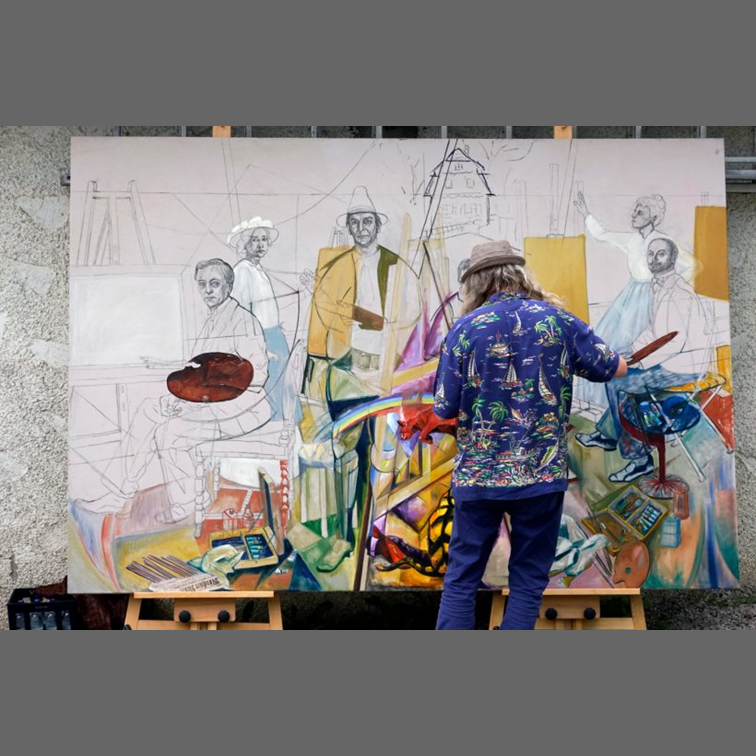LIBERATION OF FORMS AND COLORS
Expressionism
ca. 1905–1925
Expressionism: United for the revolution
The 20th century begins with several sensations. Sigmund Freud discovers the subconscious, the Lumière brothers invent filmmaking and the Wright brothers conquer the skies. Life in the modern world has become more difficult to fathom, full of pictures and – most of all – faster. In Germany, artists react with a revolution. They want to free colors and forms from their representational prisons. It is not how things appear that is important, but how they are felt. And because a revolution can only be successful when undertaken together, the artists team up to form collectives. In Dresden, Die Brücke is formed, and in Munich it’s Der Blaue Reiter. Their joint solution is called “Expressionism”. And their goal is “Abstraction”.
The influence of Der Blaue Reiter on painting in the 20th century can hardly be overestimated. However, the group within itself is much less stable and harmonious than it appears from the outside. Tensions about their artistic direction and the looming war lead to estrangement between the members. They will disband in the summer of 1914. Too soon for the aspiring artist Heinrich Campendonk, only 25 years old at the time, who hardly benefited from Der Blaue Reiter nimbus at all.
At first, Expressionism is a German phenomenon. While Cubism in France was breaking apart seeing in perspective and Futurism in Italy celebrating progress, the German avant-garde were working on the liberation of forms and colors. Expressionism is thus by definition a countermovement of Early Impressionism. It is no longer important how we see things, but how the artists express themselves in them. A change of perspective: instead of from the outside in, things are now thought through from the inside out. The artist collective Der Blaue Reiter is at the heart of this revolutions. Forms and colors are no longer bound by representationalism, but now only serve to convey artistic expression.


A first sketch for the group portrait of Der Blaue Reiter, which Beltracchi will paint using the artistic voice of Heinrich Campendonk. The depiction of the six different personalities and their painting styles pose an enormous challenge for composition of the picture. How can it do justice to all Der Blaue Reiter painters?

Wolfgang Beltracchi works on the underdrawing in his Swiss studio. This is among other things essential for orientation on the 190 x 275 cm canvas.

The underdrawings on the faces of the six artists depicted are fixated, so that the contours still partially shine through even after being painted over.

Wolfgang Beltracchi paints The Münter House on site in Murnau. He paints standing at the exact location where all Der Blaue Reiter painters in his work would actually have been. Beltracchi doesn’t just paint Kandinsky, Marc and all the others using the artistic voice of Heinrich Campendonk; he also paints various paintings on the artists’ easels using their respective artistic voices, portraying how they could each have painted The Münter House.
Expressionism
Der Blaue Reiter and Die Brücke are considered to be the two most influential artist collectives of German Expressionism. Their influence on painting in the 20th century was enormous, although both groups were only short-lived. Die Brücke existed for eight years, Der Blaue Reiter only three.
1. FROM THE INSIDE OUT
There was a 180-degree turn from Impressionism to Expressionism. Impressionism is regarded as a movement that wanted to reproduce the world as it appeared to the artist from within. Expressionism (from Latin expressio “expression”) reverses this direction. From now on, what is inside the artist is to be expressed in the things depicted. Colors and forms are thus no longer bound to objects, but are oriented towards artistic expression.
2. GERMAN-RUSSIAN CONNECTION
Three of Der Blaue Reiter members – Kandinsky, Werefkin and Jawlensky – came from Russia. However, the First World War abruptly broke up this German-Russian cooperation. Kandinsky, Werefkin and Jawlensky have to flee Germany. Marc and Macke fall on the battlefields in France.
3. ART IN PRACTICE AND IN THEORY
Der Blaue Reiter artists are not only productive with the brush, but also with the pen. Kandinsky and Marc especially compose numerous written works, which are meant to be an art theoretical accompaniment to the Expressionist Revolution. This reflection on their own works and artistic paths calls into question the sovereignty of critic’s opinions. At the beginning of the 20th century, that is also avant-garde.
4. MORE THAN JUST PAINTING
The Expressionist Revolution extends beyond painting. The liberation of forms and colors corresponds in music with the liberation of harmonies from tonality, and in poetry with the liberation of sound from meaning. Painting, music, poetry: this trio of arts is also reflected in the artists’ lives. Franz Marc is close friends with the expressionist poet Else Lasker-Schüler. And a self-portrait by Arnold Schönberg, composer and occasional painter, is shown in Der Blaue Reiter’s first exhibition.
5. A FATAL MISTAKE
Many artists in Germany believe the war that is breaking out over Europe to be a force of nature and a purifying force. Franz Marc is convinced that the war is a “healing, albeit cruel, passage”. The general mood is permeated with a desire for departure and change. But Marc and his comrades-in-arms confuse the aesthetic revolution with the real horror of war. True understanding only comes on the battlefield: “The war is of a nameless cruelty. You’re gone before you know it,” writes Macke from the front. Macke, Marc and many other artists of the time pay for the error in judgement with their lives..
Eras of art in the KAIROS project
Medieval art
Early Netherlandish painting
Italian Renaissance
Mannerism
Early Baroque
Rokoko